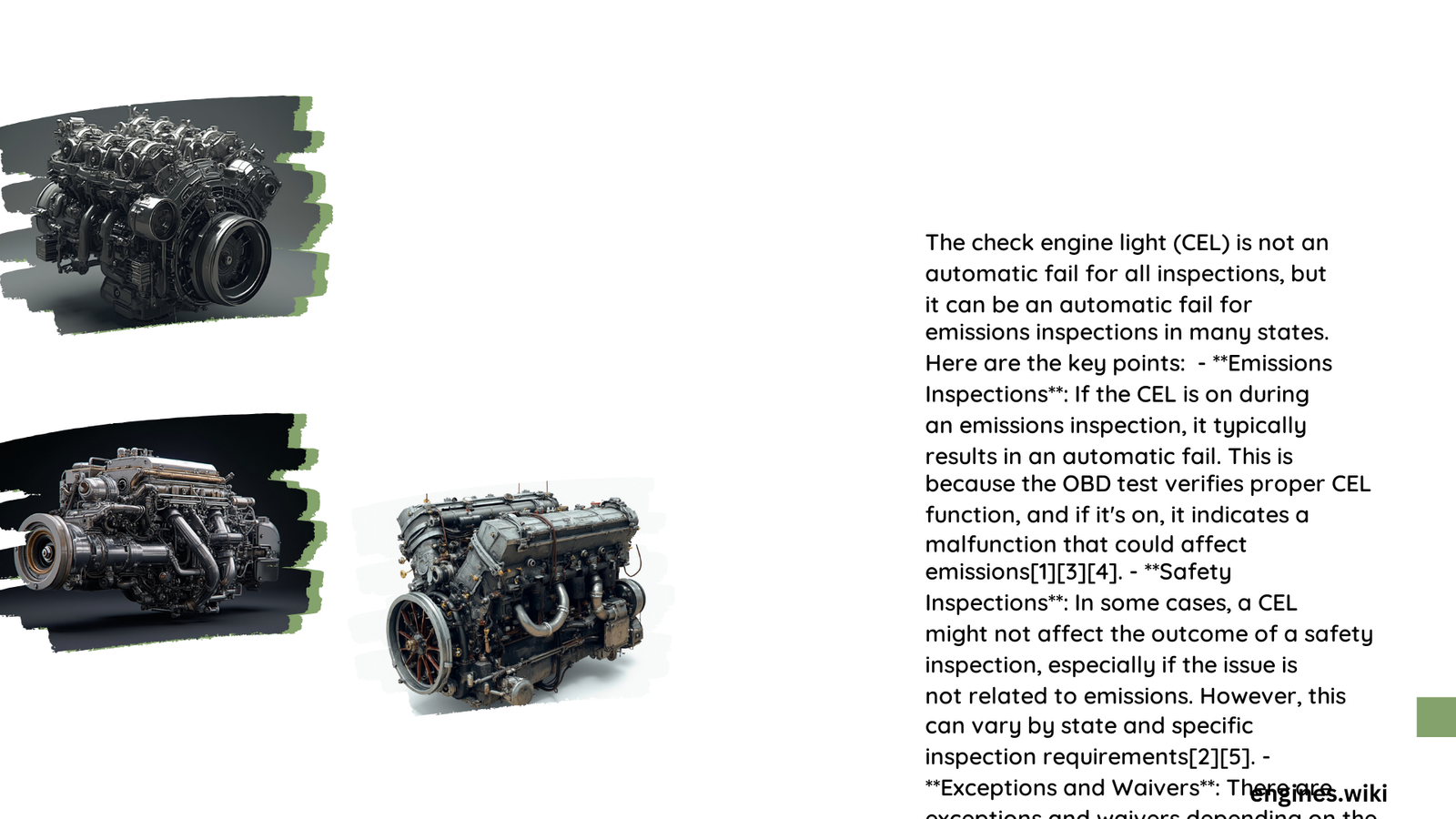The check engine light (CEL) is a crucial indicator in modern vehicles, signaling potential issues with the engine or emissions system. When it comes to vehicle inspections, particularly emissions tests, the illumination of this light can have significant consequences. In most cases, a lit check engine light results in an automatic failure during inspections. This article delves into the specifics of how the check engine light impacts vehicle inspections, its implications, and what vehicle owners need to know.
What Does the Check Engine Light Mean for Vehicle Inspections?
The check engine light serves as a warning system for various vehicle issues. During inspections, particularly emissions tests, a lit CEL typically leads to an automatic failure. Here’s why:
- OBD II System Check: Most modern vehicles (1996 and newer) undergo an OBD II inspection. This system monitors the vehicle’s emissions-related components and systems.
- Malfunction Indicator Lamp (MIL): The check engine light is also known as the MIL. If it’s illuminated during the inspection, it indicates a problem that needs addressing.
- Emissions Compliance: A lit CEL suggests that the vehicle may not be meeting emissions standards, which is a critical part of many inspection processes.
Why Is the Check Engine Light an Automatic Fail?

Several factors contribute to the check engine light being an automatic fail during inspections:
- Indication of Emissions Issues: The CEL often signals problems that could lead to increased emissions.
- Potential Safety Concerns: Some issues triggering the CEL might affect vehicle safety.
- Regulatory Compliance: Many states and jurisdictions have strict regulations requiring vehicles to pass emissions tests with the CEL off.
What Are Common Causes of Check Engine Light Activation?
Understanding the reasons behind a lit check engine light can help vehicle owners address issues before inspections:
- Loose or faulty gas cap
- Oxygen sensor malfunction
- Catalytic converter problems
- Mass airflow sensor issues
- Spark plug or ignition coil failures
How Can You Prepare for an Inspection with a Check Engine Light On?
If your vehicle’s check engine light is on, consider these steps before an inspection:
- Diagnostic Check: Use an OBD II scanner or visit a mechanic to identify the specific issue.
- Address Minor Issues: Some problems, like a loose gas cap, can be easily fixed.
- Professional Repair: For more complex issues, seek professional assistance to resolve the problem.
- Clear Codes and Drive: After repairs, clear the codes and drive the vehicle to ensure all systems are ready for inspection.
What Are the Specific DMV Regulations Regarding Check Engine Lights?
DMV regulations can vary by state, but generally:
- In New York, a lit CEL is an automatic fail for emissions tests.
- California requires the CEL to be off and all OBD II monitors to be ready.
- Many states follow similar guidelines, requiring the CEL to be off for a pass.
Are There Any Exceptions to the Automatic Fail Rule?
While rare, some exceptions may exist:
- Older Vehicles: Cars manufactured before a certain year might be exempt from OBD II testing.
- Specific Jurisdictions: Some areas may have different rules for certain types of vehicles or under specific circumstances.
- Temporary Waivers: In some cases, temporary waivers might be granted if certain conditions are met.
What Should You Do If Your Vehicle Fails Due to a Check Engine Light?
If your vehicle fails inspection due to a lit CEL:
- Get a Diagnostic Report: Obtain a detailed report of the issue causing the CEL.
- Address the Problem: Fix the underlying issue, whether it’s a simple repair or more complex maintenance.
- Retest: Once the problem is resolved and the CEL is off, schedule a retest.
How Can Regular Maintenance Help Prevent Check Engine Light Issues?
Preventive maintenance is key to avoiding CEL-related inspection failures:
- Regular oil changes
- Timely replacement of wear items (spark plugs, filters)
- Addressing minor issues promptly
- Following manufacturer-recommended maintenance schedules
What Are the Long-Term Implications of Ignoring a Check Engine Light?
Ignoring a lit CEL can lead to:
- Increased Emissions: Potentially harmful to the environment
- Reduced Fuel Efficiency: Costing more in fuel consumption
- More Severe Engine Damage: Leading to costlier repairs in the future
- Safety Risks: Some issues could compromise vehicle safety
Conclusion
The check engine light is indeed an automatic fail in most vehicle inspection scenarios, particularly for emissions tests. Understanding its significance, addressing issues promptly, and maintaining your vehicle regularly are crucial steps in ensuring your vehicle passes inspections and operates efficiently and safely.
References:
1. Family Handyman – Can You Pass a Car Inspection With Check Engine Light On?
2. NY DMV – Motor Vehicle Inspection Regulations
3. NY DMV – New York State Vehicle Safety/Emissions Inspection Program
